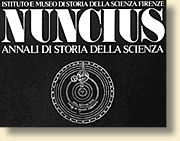
Institute and Museum of the History of Science, Florence, ITALY

1997/2
|
| Letture galileiane | |
| P. REDONDI, I fondamenti metafisici della fisica di Galileo | pag.267 |
| M. REES, Stars, Life and the Cosmos | pag.291 |
Articoli |
|
M. BUCCIANTINI,
A Difficult Legacy: Galileo and the Galilean Collection Between Myth
and History |
pag.311 |
M. J. RATCLIFF
- M. L. BUSCAGLIA, Chercheur, observateur et Monde savant au XVIIIe
siècle: la recherche scientifique dans l'immaginaire de Charle Bonnet |
pag.329 |
M. CAVAZZA,
La ricezione della teoria halleriana dell'irritabilità nell'Accademia
dele Scienze di Bologna |
pag.359 |
G. BRUZZANITI,
A Historiographic Model of the Dynamics of Scientific Theories and the
Formation of Concepts: The Case of the Atomic Nucleus |
pag.379 |
| Strumentaria | |
G. BRUSA
- J. H. LEOPOLD, The Vertical Stackfreed. Mechanical Evidence and Early
Eye-Witnesses |
pag.411 |
G. PATERNOSTER
- R. RINZIVILLO - E. SCHETTINO, Nota su una lente per cannocchiale firmata
«Domenico Selva» |
pag.427 |
| Per un archivio della corrispondenza degli scienziati italiani | |
F. BARBIERI
- F. CATTELANI DEGANI, Tre lettere di Geminiano Montanari a Gian Domenico
Cassini |
pag.433 |
R. GATTO
- L. CARBONE, Il carteggio di Fondo Siacci della Biblioteca
del Dipartimento di Matematica «Renato Caccioppoli» dell'Università
«Federico II» di Napoli |
pag.443 |
| Istituzioni e fondi | |
M. CIARDI,
Men of letters and science. The case of Xavier de Maistre |
pag.447 |
Discussioni critiche |
|
| F. GIUDICE, Thomas Hobbes and the Atomism: A Reappraisal | pag.471 |
V. TROMBETTA, Le scienze in biblioteca. Il VII Congresso degli Scienziati Italiani |
pag.487 |
R. URBANI, L'uomo e la macchina. Un Congresso di trent'anni fa |
pag.497 |
Nova Media |
|
M. BERNI - L. BARATTIN, Il Museo di Storia della Scienza di Firenze su Internet |
pag.525 |
Recensioni |
pag.533 |
| Schede | pag.617 |
Attività di ricerca |
|
| M. J. GORMAN, The Correspondence of Athanasius Kircher | pag.651 |
| Back to contents |
1997/1 |
J. CHABÁS, Le
cahier d'astronomie d'un croisier du XVe siècle. |
pag.3 |
M. BERETTA, Humanism
and Chemistry: The Spread of Georgius Agricola's Metallurgical Writings. |
pag.17 |
O. HANNAWAY,
Reading the Pictures: The Context of Georgius Agricola's Woodcuts. |
pag.49 |
A. BORRELLI,
Dall'innesto del vaiolo alla vaccinazione jenneriana: il dibattito scientifico
napoletano. |
pag.67 |
G. L'E. TURNER,
An Astrolabe belonging to Galileo? |
pag.87 |
P. TODESCO, Il
micrometro filare di Giacomo Lusverg (anno 1677). |
pag.93 |
Per un archivio della corrispondenza degli scienziati italiani: |
|
M. SEGRE, Le lettere di Giuseppe Peano a Felix Klein. |
pag.109 |
| Istituzioni e fonti: | |
G. RAMBALDI, «Stromenti e macchine» di fisica in un documento del 1785. |
pag.123 |
| Commission on Bibliography and Documentation of the IUHPS. K. D. WATSON, Sources for the History of Science in Oxford. |
pag.131 |
| Discussioni critiche: | |
S. CASATI, Convegno di studi: Scienza, tecnica e «pubblico bene» nell'opera di Giovanni Arduino (1714-1795). |
pag.137 |
| M. SEGALA, Ampère filosofo. | pag.145 |
| Recensioni | pag.161 |
| Schede | pag.221 |
| Attività di ricerca | |
F. ANDREINI, Il progetto «Ca. Fo. S.». Catalogo dei Fondi Scientifici toscani. |
pag.257 |
|
|
|
|
|
|
|
For further
information, please contact: |